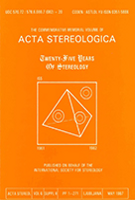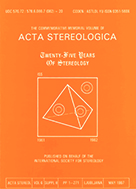- Portada
- Volume 14 (1995)
- Number 2 - Quantitative image analysis - Nov. 1995
- Morphological image segmentation
Vista(s): 605 (5 ULiège)
Descargar(s): 88 (1 ULiège)
Morphological image segmentation

Abstract
Morphological image segmentation is based on MISP (Morphological Image Segmentation Paradigm), due to S. Beucher and F. Meyer. Its central operation is the watershed. The paradigm itself is a complex transformation with two inputs, namely the function f to be segmented and the set M of markers, and one output, namely the (binary) contours of the segmentation.
The input functions may be scalar, or vectorial ones (e.g. colour images). They are defined in one, two or three dimensions, over Euclidean spaces, regular grids, or irregular graphs. The two inputs f and M interact via the swamping operation. The swamping of function f with respect to set M is the lower over-estimation of f whose minima coincide with the connected components of M. It is obtained by a procedure of reconstruction closing. Hence the techniques of morphological connected filtering intervene in the paradigm. As a matter of fact they are often also used prior to the MISP for filtering the function under study. A first pedagogical example is given, it shows the successive steps of the paradigm. It is followed by two original algorithms applied to already known images.






